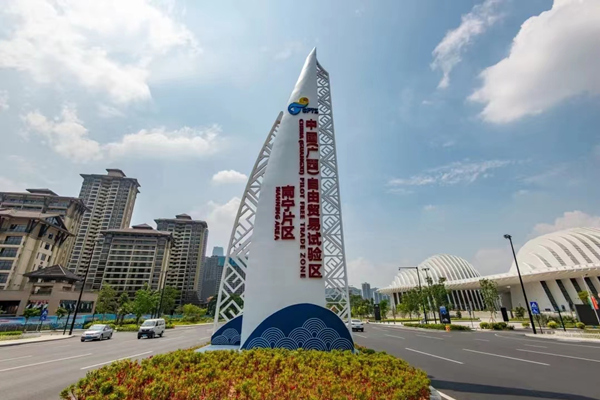Guangxi FTZ utilizes $685m in foreign investment in 2022
In 2022, the China (Guangxi) Pilot Free Trade Zone (FTZ) utilized $685 million in foreign direct investment, up 140.34 percent year-on-year and accounting for 50 percent of Guangxi's total.
Guangxi has reached cooperation agreements with 13 overseas investment cooperation organizations from Singapore, Germany, and the United States to form a cross-border industrial and supply chain oriented around ASEAN.
An RCEP government affairs service center has been set up in the Nanning area of the Guangxi FTZ, while the China-South Korea (Guangxi-Gangwon) Industrial Park project has been put into operation, becoming the first cooperation project between Guangxi FTZ and South Korea.

The Nanning area of the Guangxi FTZ. [Photo/WeChat account: gh_df8bc987e060]
In 2022, there were 126 new financial institutions in the China-ASEAN Financial City, and nearly 20 foreign-funded financial institutions. In addition, 120 new foreign-funded enterprises were established last year, accounting for about 70 percent of new foreign-funded enterprises in the Guangxi FTZ, with the actual utilized foreign capital increasing by 180 percent year-on-year.
The Qinzhou Port area of the Guangxi FTZ promoted the expansion of Phase II of the Jingui Pulp and Paper project, which is expected to have an annual output of 1.8 million metric tons of high-grade cardboard and 750,000 tons of chemical pulp, with a total investment of 11.8 billion yuan ($1.7 billion). The foreign direct investment value in the Qinzhou Port area of the Guangxi FTZ was $213 million.
The Chongzuo area of the Guangxi FTZ has been promoting the development of the deep processing industry of ASEAN characteristic products, building cross-border industrial chains. The output value of the deep processing industry of ASEAN characteristic products and the cross-border electronic information industry accounted for more than 40 percent of the total industrial output value of Pingxiang, a county-level city in Chongzuo.
